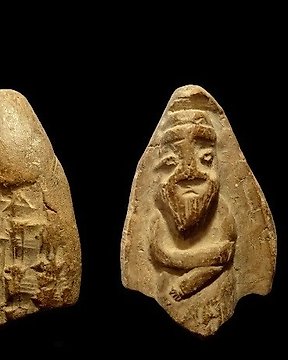
Mesopotamien Terrakotta Kilskriftstavla - akkadisk - med karaktär i relief - sällsynt!
Nr 82325551

Nr 82325551

Ancient Etruscan votive heads were small terracotta sculptures representing human heads that were created by the Etruscan civilization, which flourished in the central region of modern-day Italy from the 8th to the 3rd centuries BCE. These votive heads were typically made as offerings to deities or spirits and were often placed in sacred spaces such as temples, sanctuaries, and tombs.
Votive offerings were a common practice in many ancient cultures, including the Etruscans. These offerings were made as a way to express gratitude, seek protection, or request favor from the divine. Etruscan votive heads are considered some of the most remarkable and distinctive artifacts of Etruscan art.
The Etruscan votive heads are characterized by their unique stylistic features. They often depict individuals with distinctive hairstyles, facial features, and jewelry. The heads are usually not attached to full bodies but rather present the face and sometimes a portion of the neck. Some votive heads show evidence of having been painted, enhancing their lifelike appearance.
The exact purpose of these votive heads is still a subject of scholarly debate. They might have represented specific individuals, deities, or even the worshippers themselves. The heads are thought to have served as intermediaries between the mortal realm and the divine, conveying prayers and messages to the gods.
Etruscan votive heads provide valuable insights into the culture, aesthetics, and religious practices of the Etruscan people. These artifacts have contributed significantly to our understanding of the Etruscan worldview and their interactions with the spiritual realm.
Etruscan devotees often deposited offerings of terracotta heads, apparently stylized portraits, for favors anticipated or received from the gods. Such offerings were frequently buried in special trenches within a sacred precinct.
Epoque :
Etrusque du 5ème au 4ème siècle avant J-C.
Provenance :
Collection privée belge formée entre 1975 et 1980 par le Docteur J. M.
Dimensions :
Hauteur : 27 cm sans le socle.
Largeur : 17 cm.
Conservation :
Petit éclat visible dans l'oeil gauche, petit fêle de cuisson visible à l'arrière sinon
très bon état de conservation.
Une facture et un certificat d'authenticité sera remis à l'acheteur.
Envoi par DHL Express avec assurance.
Pour l'expédition de biens entre les pays membres de l'UE, aucun permis d'exportation n'est nécessaire. Le vendeur garantit avoir acquis ce lot par des moyens légaux et qu'il ou elle est en possession des permis nécessaires. Le vendeur informera l'acheteur des précisions susmentionnées dans le cas où l'acquisition des permis nécessaires et l'expédition du lot prendraient de quelques jours à quelques semaines.
#ancientcivilisations
Hur du köper på Catawiki
1. Upptäck något speciellt
2. Lägg det högsta budet
3. Gör en säker betalning